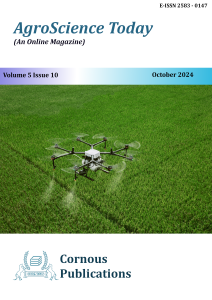Cajanus cajanifolius is the progenitor of the cultivated species Cajanus cajan – the redgram. The protein content is 22%. The centre of origin is India. On mountain slopes, it is cultivated for erosion control. Optimum temperature range is 20-280C. 58 growing degrees are required for redgram as against the 70-75 degree days of soybean and groundnut. This crop can’t tolerate waterlogging and frost. Well, adapted to drought condition. Salinity tolerant; thrives well in 5-8 pH. The salinity tolerant gene from rice is inserted in to the redgram. LAI is in the range of 4-6. Profuse flowering is observed. Flower dropping is more resulted in poor pod setting ratio. Harvest index is very less 0.11 to 0.22. 90x30 cm and 50x20 cm are the recommended spacings. 20-30 kg is the seed rate recommended. Ragi+ redgram, sorghum + redgram, pearlmillet + redgram and groundnut + redgarm are some of the intercropping systems practiced in India. 90% yield loss is obtained due to weeds. 30 days is the critical crop weed competition period. Pod borer is the major pest of redgram. Prophylactic spray of indoxacarb is recommended. Wilt is the major disease for which resistance varieties are evolved.
The current state of agriculture appears promising, but beneath this bright outlook lie significant challenges such as labour shortages, effective crop monitoring, and the timely application of chemicals. Additionally, the precise use of agricultural inputs like fertilizers, pesticides, and growth regulators is crucial for maximizing benefits while minimizing environmental impact. In this context, drones have emerged as a valuable technological tool for agricultural practices and related activities. Their use not only helps reduce input costs and improve monitoring but also opens up new opportunities for jobs and entrepreneurship. By adopting this technology, farmers can unlock new possibilities, optimize their operations, and contribute to a more resilient and food-secure future.
Wheat (Triticum aestivum L.) is one of the most important staple crops worldwide, providing a substantial portion of the daily calorie intake for millions of people. In India, wheat is second only to rice in terms of cultivation and consumption. Historically, wheat production has been concentrated in the northern Indo-Gangetic plains, but in recent years, there has been growing interest in wheat cultivation in Peninsular India. This region, which includes the states of Maharashtra, Karnataka, and Andhra Pradesh, has unique agro-climatic conditions that present both challenges and opportunities for wheat production. This article delves into the genetic variability, agro-climatic adaptability, and breeding efforts in Peninsular India that aim to enhance wheat productivity in this relatively underexplored region.
